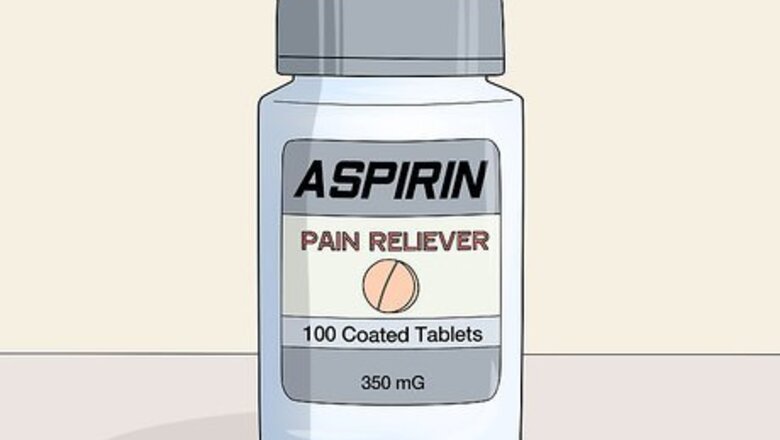
views
X
Research source
If you do experience brain swelling, the following treatments can help reduce the swelling and lead to your recovery. Since brain swelling is a potentially life-threatening condition, all of the following treatments should be done under the direction and supervision of your doctor.
Taking the Correct Medication

Use over the counter pain relievers to reduce headaches. For minor head injuries that caused minimal swelling and didn’t cause unconsciousness, your doctor may not order any further treatments. Follow your doctor's guidelines and take OTC pain relievers to help with the residual headaches and rest while the injury heals. Always take the medication exactly how your doctor told you to. Always take the exact medication that your doctor tells you to. Depending on what caused your edema, certain medications like Aspirin can make it worse by thinning your blood. Keep your doctor informed if your condition gets any worse, like if you experience increased pain, confusion, dizziness, or nausea.

Take corticosteroids to reduce the inflammation. Corticosteroids are a common treatment for many kinds of swelling and inflammation. They are prescription drugs, so your doctor has to write you a prescription and give you instructions on how to take the correct dosage. Follow the doctor’s directions to use the medication correctly. Your doctor may prescribe corticosteroids as a sole treatment for swelling, or after a medical procedure. These drugs are used most often for brain tumors and following surgery.
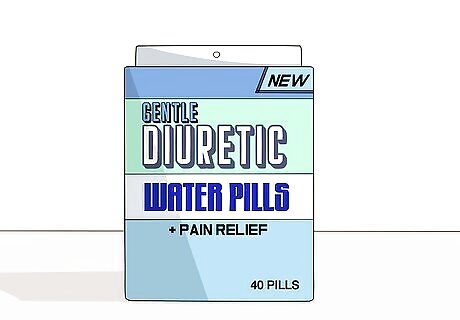
Drain fluid away from the brain with diuretics. Diuretics make you release more urine, draining the overall amount of fluid in your body. They are sometimes used after brain injuries to draw fluid away from the brain and create more room in the skull. Diuretics are usually administered with an IV drip in a hospital setting. If your doctor thinks you’re well enough, they may release you with a prescription diuretic pill. Take them exactly how the doctor orders you to.
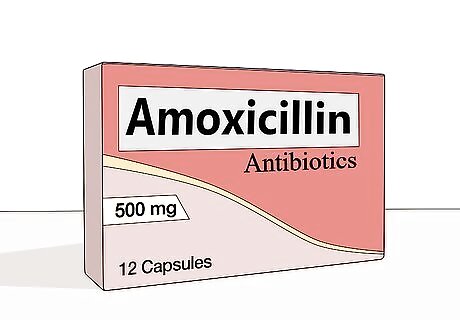
Use antibiotics if the swelling is caused by a bacterial infection. Some bacterial infections like meningitis or encephalitis also cause brain swelling. Various antibiotics are used to fight these infections. Doctors will probably administer these drugs in a hospital setting until you’ve healed well enough to go home, and then write you a prescription to continue fighting the infection. Always finish the entire course of antibiotics, even if you're feeling better, to ensure that all the bacteria dies off. If your antibiotics are causing severe side effects, call your doctor to ask if you can switch to an alternative medication. However, don't stop taking the antibiotic without checking with your doctor first. Antibiotics commonly cause stomach upset, so try taking them with a meal or light snack like crackers to prevent adverse side effects. Don't do this if your doctor tells you to take the medicine on an empty stomach. Your doctor may try a few different antibiotics to see which one fights the infection best. Remember that bacterial infections are communicable diseases, so limit your contact with other people until you’ve healed and can no longer infect others. Viral infections can also cause brain swelling, but antibiotics are not effective in fighting these conditions. Doctors will probably treat these infections with corticosteroids, fluids, and antivirals.
Receiving Medical Procedures

Conduct a controlled hyperventilation to decrease the brain’s volume. Your doctor may be able to temporarily reduce brain swelling using a hyperventilation treatment. During the treatment, your medical team will induce hyperventilation by pumping more oxygen into your body, causing you to exhale more than you inhale. This burns off more carbon dioxide and reduces blood flow to the brain, decreasing the pressure in your skull. During the treatment, you'll be intubated so you're able to receive more oxygen. This treatment is typically used when your brain swelling is caused by trauma, and the results are temporary. If hyperventilation is successful in reducing the swelling, the doctor may still send you home with a prescription for corticosteroids or keep you in the hospital for observation.
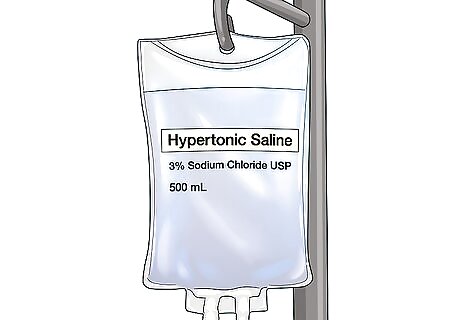
Have an osmotherapy treatment to draw fluid away from the brain. Osmotherapy uses drugs to draw fluids away from the brain. This reduces the pressure in your skull by shrinking your brain. This sounds like a scary procedure, but it is not invasive and is administered with a normal IV drip. Osmotherapy has been used to treat brain swelling since the 1960s. Osmotherapy is a common treatment for brain swelling related to injuries, strokes, and infections. Some researchers have recently questioned how effective osmotherapy is for edema patients. Your doctor may only use this option in very specific circumstances.
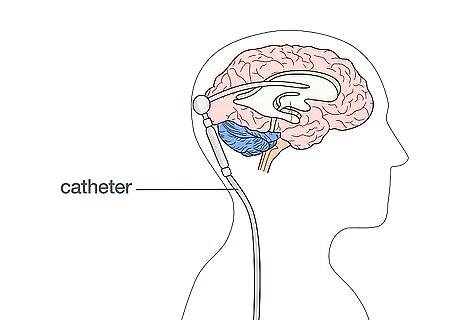
Drain fluid out of the skull with a catheter. This is a more invasive option, but doesn't cause lasting pain or side effects. Surgeons will insert a drain or catheter into the skull through a very small hole behind your ear. This draws fluid out of the skull cavity to create more room for the brain. The drain is temporary and will be removed when you recover. This is a common treatment for people who have bleeding on the brain from an injury or stroke. It is usually a last resort before performing surgery.Variation: You might get a permanent shunt with a catheter if you have a chronic brain swelling condition, such as hydrocephalus. Your catheter will drain the excess fluid away from your brain and down into your abdomen where it can be reabsorbed by your body.
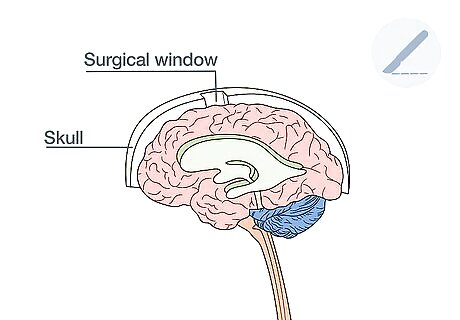
Have a surgical window made in your skull. The final option to treat brain swelling is surgically removing a small part of the skull. This opens up more room for the brain and reduces pressure in the skull cavity. Again, this sounds scary, but it's a normal treatment for brain swelling that doesn't have lasting complications. Once your condition improves, surgeons will replace the piece of skull so you don’t have a permanent hole. This is a common treatment for people who have experienced serious head injuries or have an active bleed that surgeons can't control.
Caring for the Injury at Home
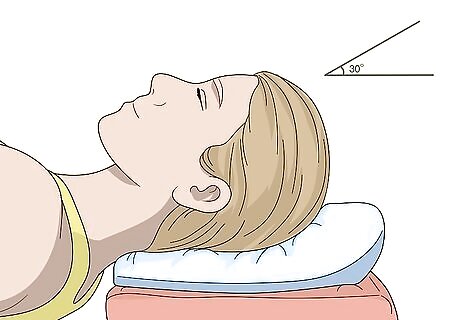
Tilt the end of your bed up so your head is elevated. Elevating the head about 30 degrees up is ideal for draining fluids away from the brain. In the hospital, nurses will probably set your bed at this angle. Continue doing this at home, either by piling pillows under the neck or getting an adjustable bed. Ask your doctor how long you have to continue this treatment. Keep your head elevated if you’re laying on the couch as well. Use pillows to angle your head up.

Eat omega-3 fatty acids to help your brain repair itself. Omega-3s help your body repair itself and prevent inflammation. They can also improve brain function to help you through the recovery process. If you’re recovering from brain swelling, increase your intake of these nutrients to help speed your recovery. The official daily recommendation for omega-3s is 1.1 g for women and 1.6 g for men. Good sources of omega-3s are fatty fish like salmon and sardines, nuts, seeds, plant oils, and fortified dairy products like eggs, milk, and yogurt.
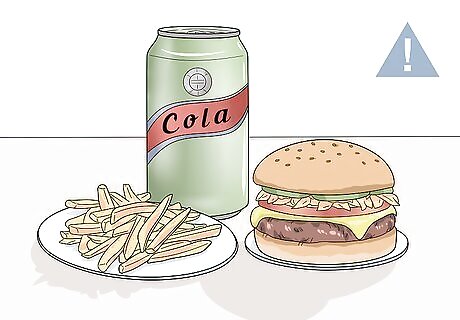
Limit your intake of saturated fats. In contrast to omega-3s, saturated fats increase swelling and inflammation in the body. Increased inflammation could do further damage if you’re recovering from cerebral edema. Cut saturated fats out of your diet while you recover. Processed foods, fast food, candy, sugary drinks, and red meat are all high in saturated fats. Replace these foods with fresh, non-processed options.

Do light cardiovascular exercises if you’re able to. Light exercise like walking on a treadmill, jogging, or swimming has a positive effect on the healing process. When your doctor says you’re healthy enough, start incorporating physical activity into your routine. Aim for 30 minutes of light exercise every day for the best results. Only exercise if your doctor tells you it’s safe. Physical activity before you’re fully healed is dangerous and could delay your recovery. If you’re recovering from a brain condition, avoid any activities that could injure your head. Biking and contact sports are very dangerous after you’ve had a brain injury.

















Comments
0 comment